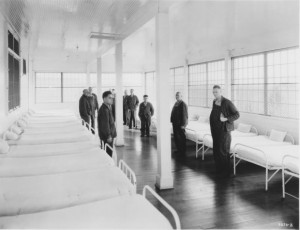When Dr. John Maurice Grimes inspected mental institutions in the U.S. (see last two posts), he discovered that the federal asylum in Washington, DC, (St. Elizabeths) was overcrowded. Continue reading
Author Archives: Carla Joinson
Federal Facilities for the Insane
When Dr. John Maurice Grimes published Institutional Care of Mental Patients in the United States at his own expense (see last post), he was able to speak freely about his findings.
His comments about Veterans Administration hospitals which treated mental patients were heartening: on the whole, he found VA facilities almost always situated on pleasant plots of land with room for necessary buildings and recreational activities. Continue reading
The Truth Not Welcome
In January, 1931, the Board of Trustees of the American Medical Association appropriated $20,000 for the study of all institutions “caring for either the mentally ill or the mentally deficient of the United States.”
Which Was Worse?
State insane asylums are usually thought to be a little (or a lot) worse than private institutions, and that is probably true in many cases. Private asylums had a bit more freedom in accepting patients and in hiring staff, and that was often reflected in the their general atmosphere and the treatment of patients. However, private institutions could have their own problems. Continue reading
Where Do You Go?
Nearly every patient in an insane asylum wanted out. Asylum superintendents often put up roadblocks to this when they didn’t feel a patient was well enough to go home; there are many accounts of clashes between the asylum’s medical staff advising against removal, and patients’ families who thought they looked or seemed well enough to come home. Continue reading
Misery on Display
Most patients, of course, did not want to be in an asylum, and moving into one very likely added to whatever problem that had brought them there. Doctors’ management of their conditions may or may not have alleviated their distress (see last post), since much of the available medication in the 1800s and early 1900s had undesirable or unpleasant side effects.
A Delicate Balance
Superintendents at insane asylums had every incentive to cure patients, since high cure rates brought both prestige and validation to their institutions. This is one reason that they urged families to get their loved ones into an asylum quickly, before the mental illness became established and more difficult to alleviate or cure. Continue reading
What Do You Learn?
Modern researchers sometimes pass judgment on whether or not a person should have been committed to an insane asylum–but It isn’t always an easy call. Reading patient notes can lead one to believe that disruptiveness rather than insanity caused a commitment (see last post), or that patients were committed for conditions that we realize today have nothing to do with insanity, such as epilepsy. Continue reading
So Easy to Leave
Certain patients with mental illness were more difficult to manage than others, and families often grew tired of coping with a disruptive member who perhaps drained them physically and emotionally. An asylum offered a wonderful solution to the problem, and some families were quick to leave a relative at one and never look back. Continue reading
Commit and Forget
Spectacular cases of involuntary commitment have found their way into newspapers and books and are interesting to read about, but in reality, many families were reluctant to commit their loved ones to an asylum. Authorities hoped that their magnificent buildings and varied amenities would reassure family qualms so that patients would be admitted before their cases became chronic. Continue reading









